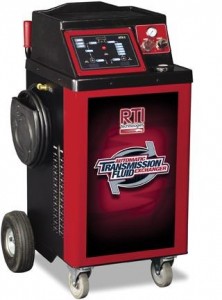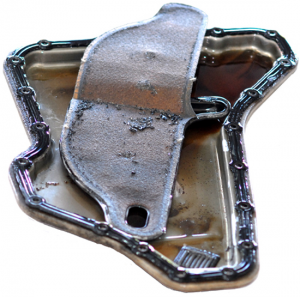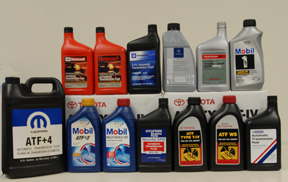The importance of a transmission flush often goes unnoticed until serious problems arise. It is a process that is important to the health and maintenance of your car, and if done properly, is an excellent preventative maintenance procedure. Check your owner’s manual for the proper maintenance schedule. However, if you feel there are certain problems with your vehicle such as odd noises or gear shifting issues, it might do more harm than good.
What Transmission Do I Have?

In This Guide
- Definition
- Average Cost
- Effectiveness
- Flush vs. Change
- Process – How it’s Done Properly
- Fluids
- How Often Should it be Done?
- Finding a Reputable Service Provider
Definition
 A transmission flush is a maintenance process where all of the oil in a transmission is removed, new oil (and sometimes cleaning solutions) is run through it using a special machine to push out grime and sludge and then it is filled up with new oil. The process is used to remove debris and sludge and replace 100% of the used oil with fresh, clean quarts.
A transmission flush is a maintenance process where all of the oil in a transmission is removed, new oil (and sometimes cleaning solutions) is run through it using a special machine to push out grime and sludge and then it is filled up with new oil. The process is used to remove debris and sludge and replace 100% of the used oil with fresh, clean quarts.
Average Cost and Factors
The typical price range for a transmission flush is $125 to $250 – approximately twice as much as a fluid change due to the additional fluid required (12-22 quarts instead of 5-7 quarts) to completely replace the old fluid. The average you can expect to pay is $150 for the full service.
| Transmission Flush vs. Change Cost | |
|---|---|
| Flush | $125 to $250 |
| Change (Shop) | $80 to $150 |
| Change (DIY) | $40 to $90 |
The cost depends on several factors including your car’s make and model, your location, the type of shop you go to, the machine they use and any additional services such as pan removal and filter replacement. For example, at a quick lube shop the cost ranges from $100 to $200, while a dealership will charge between $150 and $300.
Factors that Affect the Cost
- Year, make and model of your car/transmission (high end cars cost more)
- Your location (cities have a higher cost of living/labor)
- Type of shop (quick lube, independent mechanic or dealership)
- Type of flushing machine (pump inlet or cooler line)
- Type of fluid used (synthetic is more expensive)
- Amount of fluid required (11-21 liters)
- Additional services (filter replacement, pan removal)
Note: We highly recommend choosing a service that includes pan removal and a new filter. This will add to the cost, but it will help extend the life of your transmission.
Effectiveness
There are debates as to the effectiveness of this procedure. Some state that flushing your vehicle using professional equipment may actually damage your vehicle. They say that the gunk and residue that are being flushed out may actually get lodged somewhere where it shouldn’t be, which could cause failure sometime in the future. Some believe that valves and seals may be bent or weakened with the pressure some machines use to force cleaning solution and fluid through the lines.
On the other hand, most agree that it is a legitimate maintenance procedure for your vehicle. They believe that a flush can help remove residue and materials from the engine, improving its performance and its lifespan. Whenever you are considering having one done, consult your owner’s manual first, then your dealership or local service center.
Flush vs. Change
A flush uses a professional grade machine to completely flush all the transmission fluid from your vehicle and remove some grime and contaminants from the torque converter and cooler lines to prevent them from causing transmission problems. This process involves running a special solution through the lines until they come out completely clean and then fills up the system with new fluid.
A fluid change on the other hand simply drains it using natural gravitational forces. Not all the fluid in the system is drained using this method and it does not flush out contaminants. Most say it only drains between 20%-40% of the total volume.
The goal of both changes and flushes is to improve and extend the life and performance of your car.
Process – How it’s Done Properly
Before hooking your car up to the machine, a technician should take it on a test drive in order to recognize and diagnose any serious problems that should be looked into during inspection and servicing. The unit should also be inspected for any external signs of problems or leaks.
A professionally done procedure requires the use of specialized, government regulated machines. There are a few ways in which these machines differ in their performance and operation, but you can discuss the type of machine and method used with your mechanic.
Machines typically connect to the cooler lines. The line that connects your vehicle’s transmission to the cooler will be disconnected and attached to the machine’s line in. This will allow the car’s fluids to drain into the machine. The line out from the machine then connects to your car’s cooler. This allows the new fluid in the machine to be transferred into the vehicle. The transfer process only utilizes the pressure produced by the car’s pump to circulate it, so no damage can be done to the internal parts of the system.
As the old fluid side of the diaphragm fills, it pushes the new fluid diaphragm up, making it flow through the lines. It circulates just as it would under normal operating conditions, the only difference being that the incoming oil is perfectly clean and the outgoing liquid is gone for good. The one downside of this process is that due to the way that fluid cycles through the unit, some of it is dropped back into the pan without going to the cooler. This means that the old is not completely replaced, but is continuously diluted with new oil instead.
Another method used is a pump inlet flush. This method attaches the machine’s line out to the pump intake. The process transfers fluid through the vehicle and into a drainage pan, completely flushing the system. When cleared, new fluid is supplied to fill up the car. This process requires the complete removal of your pan and filter and a new filter and pan are installed at the end. This requires more time, a few extra quarts of fluid (around 20) and costs a bit more, but it is a much more complete, ideal procedure.
Note: Some service centers use machines that add additional force to blast fluid and/or cleaning solution through the system. This is NEVER a good idea as this can damage seals and/or lodge sludge in places it shouldn’t be as mentioned above.

A complete service should ideally include removing the pan and inspection of the old oil to look for signs of current or near-future issues. Dropping the pan is important because the used fluid, what is lying in the pan and what is trapped in the filter will all tell you a lot about what condition it is in. Some of the gunk that is flushed ends up in the pan and is then sucked up into the filter. If the filter becomes too clogged, then the pump will starve for fluid, components will not get lubricated which leads to heat, friction, slippage and eventually failure.
Normally, and this varies between year, make and model, darkened oil with some debris or residue is normal. Metal flakes may be seen in the oil or the plug. However, if you notice an excess of gunk, grime, or metal flakes; if there is a burning smell or other unusual odors or the oil is black, it often means that your car has (or will soon have) some serious issues.
It is recommended to always have the filter replaced regardless of whether you’re getting a fluid change or flush (some vehicles do not have one that is replaceable). Some gaskets may still be “usable”, but it is always best to replace both filters and gaskets.
Overall, the key to maintaining a transmission is following exactly what is recommended in your vehicle’s owner’s manual. It will tell you whether you to get a flush or change and how often to have it done (after a certain number of miles or amount of time). Do not trust it’s health to something you read online or heard from a mechanic/service technician as some are just looking to get your money and do not care what is best for your transmission. (not saying all mechanics are dishonest, but they DO exist). Be sure to ask the person servicing your car to make sure they are following the proper procedures recommended above and in the manual.

Note: Flushing and changing the filter are important preventative maintenance procedures, they are not a solution for ones that already have problems or are on the way to a problem according to their black, burned and/or high-debris-content fluid. Getting a flush when you think there might be a problem can do more harm than good and make it fail faster than it would have otherwise. The same applies for higher mileage vehicles that have never had their lines flushed.
By that time the damage has already been done and there is likely a lot of sludge and varnish built up inside. The fresh additives from the new fluid attack the deposits, causing them to break off and jam valves, clog passageways, etc. In that case the tranny is doomed anyway, so your best bet is to do nothing to it, set aside some cash, and drive it for as long as you can.
Fluids
 There are different types and grades that can be purchased and used in the exchange. Some of the most recommended are full synthetic fluids. However, certain vehicles and their parts may degrade with the use of full synthetic oil. This is usually the case for older makes and models. For the most part, full synthetic will lubricate better, combat heat and friction better and last longer. However, consult your owner’s manual or a service technician for the recommended type for your particular make and model of vehicle.
There are different types and grades that can be purchased and used in the exchange. Some of the most recommended are full synthetic fluids. However, certain vehicles and their parts may degrade with the use of full synthetic oil. This is usually the case for older makes and models. For the most part, full synthetic will lubricate better, combat heat and friction better and last longer. However, consult your owner’s manual or a service technician for the recommended type for your particular make and model of vehicle.
Important: Make sure that whoever is servicing your transmission uses the right type for your vehicle and not some cheap generic/universal version that could cause problems down the road.
How Often Should it be Done?
This maintenance procedure should be performed every 30,000 miles or so. Some service centers will advise doing it every two years or 24,000 miles. You can often review your owner’s manual or speak to your dealership, however it is important to understand your driving habits and relay that information to a professional. Vehicles that are often towing or drive through sand, dirt and other harsh terrain, may require earlier service. Consult a reputable service provider if you need advice.
Alternatively, if you don’t think it is safe enough, you want to save some money by doing your own maintenance or your owner’s manual recommends changing instead, you might want to consider changing it slightly more frequently than is advised to keep the oil in a more like-new condition.
Importance of Finding a Reputable Service Provider
A reputable mechanic will advise you on several aspects. They will determine if you even need one based on your driving habits, mileage and the manufacturer’s recommendations. They will also determine the proper method to use and will do the job professionally and properly; utilizing the proper kind for your particular make and model, not finishing until the fluid appears clean and clear, thoroughly inspecting what comes out of the car, replacing all gaskets and filters and properly installing all parts back onto your car so that it runs just right. In addition, they will do all this at a reasonable price and should back their work with a warranty.
What Transmission Do I Have?

In summary, this procedure is an easy, low cost maintenance option to perform on your car. It is essential over the lifetime of your vehicle in order to protect it from harmful damage cause by wear and tear. It is also a great indicator of the internal health of your vehicle and will prevent costly damage over time. Transmission repair can be quite costly so it is important to do your best to maintain a healthy, properly functioning transmission.

Won’t drop into gear silinoid stuck off
Works ok but OD light goes on fashing
My 2007 cts is reading 89% fluid on the info screen but when I go to put it in drive it will not move I tryed the car in all gears and it will not move ..no leaks…no history of tranny problems what is wrong with my car